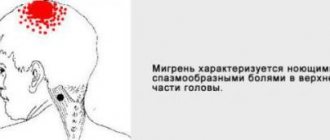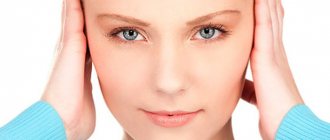Causes of headaches and ear congestion
Constant pain in the head, which causes blocking of the ears, is an alarming symptom for which you should seek medical help. It may indicate physiological changes that do not require therapy, including water entering the ear canals or fatigue. However, in some cases, this sign will help identify dangerous diseases in the early stages and begin treatment on time.
High blood pressure
Chronic hypertension is a disorder in which the pressure in the arteries exceeds normal levels. In a healthy person at rest it is 120/80 mmHg, but it is important to take into account individual characteristics. Blood pressure is considered high if it is 140/90 mmHg. and more. The condition can be caused either by an increase in circulating blood volume or by vascular spasms.
Blood pressure is easy to measure yourself using a tonometer. If the readings are too high, you should seek medical help. Without timely treatment, hypertension poses a danger to the patient and can cause the following complications:
- angina pectoris - acute pain in the chest;
- myocardial infarction - a sharp disruption in the supply of oxygen to the heart muscle;
- chronic heart failure – deterioration of the heart valve apparatus caused by increased load on it;
- arrhythmia is a disturbance in the heart rhythm that can cause a heart attack.
When blood pressure rises, the patient has a headache and pressure on the ears. Symptoms such as dizziness, nausea, hearing loss and poor coordination of movements also occur. With a sudden attack, fainting is possible. Hypertension can be triggered by an increase in atmospheric pressure, physical activity, stress, disruption of the daily routine and other factors. For chronic hypertension, it is necessary to take medications in a course, including to remove excess fluid.
Inflammation of the paranasal sinuses
Sinusitis is an inflammation of the mucous membrane of the paranasal sinuses. With this disease, the nose and ears are blocked, the head hurts, and the overall body temperature rises. The process can be caused by a viral or bacterial infection, and cold weather is often the trigger. Sinusitis occurs in acute or chronic forms and may recur after some time. In addition, the disease can manifest itself as a complication of seasonal colds.
The paranasal sinuses are cavities formed by the bones of the skull. In a healthy person, they are not filled with anything, and their walls are lined with mucous membrane. During the inflammatory process, pathological contents appear in them, which causes headaches. Sinusitis can be serous (with clear liquid contents), catarrhal (cavities filled with mucus), purulent and mixed. Depending on the location of the process, there are several types of this disease:
- sinusitis - inflammation of the maxillary sinus, often occurs as a complication of a cold;
- frontal sinusitis - the process affects the frontal paranasal sinus;
- ethmoiditis - inflammation of the mucous membrane located in the ethmoid labyrinth;
- sphenoiditis - damage to the mucous membrane of the sphenoid sinus.
At home, you can conduct an initial diagnosis of sinusitis. If you sharply tilt your head forward and down, a sharp pain occurs in the forehead. This indicates fluid accumulation in the sinuses. Also, with inflammation of the maxillary sinuses, headaches intensify at low temperatures and decrease in a warm room.
Diseases of the hearing organ
If your ears are blocked due to pain in your head, you should undergo an examination by an otolaryngologist. Chronic diseases of the organ of hearing cause a sharp deterioration in health, increased body temperature, impaired balance and coordination of movements, as well as other symptoms and complications.
- Otitis is an inflammation of the ear in any of its parts. Depending on the location, they distinguish between external, middle and internal, and according to the nature of the course - acute and chronic otitis. The process can be caused by hypothermia or herbs, as well as viral and bacterial infections. Internal purulent otitis is the most dangerous because it can spread to the membranes of the brain and cause meningitis.
- Acoustic neuroma is a benign neoplasm. Its first symptoms include constant headaches and dizziness, as well as hearing loss. Over time, nausea, loss of coordination of movements, and atrophy of the masticatory muscles appear. Neuroma does not disappear on its own and may increase in size. To treat it, surgical techniques, radiation therapy, or combined methods are prescribed.
- Mechanical damage or blockage of the ear canals is another reason why headaches and blocked ears occur. You can get injured even at home, if you do not properly clean your ears or if sharp objects get into your ear canals. The cause of the blockage is often cerumen plug - after its surgical removal, headaches disappear and hearing is restored.
If you suspect a disease of the hearing organ, you must undergo an examination by an otolaryngologist. It uses a special device - an otoscope, which allows you to detect various disorders in the auditory canals. The inner ear is difficult to access for diagnosis and has a complex structure, so it is important to prevent the spread of infection from the external parts.
Other reasons
Headache and ear congestion are common symptoms for a large number of diseases and conditions. They are not necessarily related to hearing health, so it is important to pay attention to associated signs. A more detailed examination reveals the following pathologies:
- cervical osteochondrosis is a chronic disease of the spine in which blood circulation and innervation of the tissues of the head are disrupted;
- viral diseases - influenza, ARVI also manifest themselves as headaches and hearing impairment;
- consequences of traumatic brain injuries , which can manifest themselves many years later.
These symptoms can also occur in a healthy person. So, they often bother you during a flight or in other cases of changes in atmospheric pressure, when water gets into the ear canals, during fatigue or prolonged work at the monitor. However, if they occur regularly, doctors at the Clinical Brain Institute recommend undergoing an examination and determining the exact cause.
Why does my ear hurt?
Possible Causes of Ear Pain Ear pain is most often associated with inflammation of either the outer ear (the pinna and ear canal up to the eardrum) or the middle ear (the ear cavity just behind the eardrum). In this case, they speak, respectively, of external or otitis media
. If your ear hurts, then most likely the cause is a bacterial or fungal infection in the wound or mouth of the sebaceous gland. Sometimes both the ear and throat hurt at the same time. And this is not surprising: the ear is connected to the nasopharynx and through the auditory tube, the infection can get from the nasopharynx to the middle ear, and then inflammation, causing pain, simultaneously develops in both the throat and ear.
However, ear pain often occurs for other reasons. In children, ear pain is sometimes associated with foreign objects
. If this happens, you should not try to remove the object lodged in the ear yourself - you can damage the eardrum or injure the ear.
Dense earwax plug
may also cause discomfort and pain.
Another possible cause of acute pain is a ruptured eardrum.
.
There are quite common cases when pain felt in the ear indicates a disease in other organs. Doctors call this kind of pain radiating, and people say that the pain “radiates to the ear.”
Similar pain can occur with sinusitis (inflammation of the sinuses), arthritis of the jaw joint, and inflammation of the trigeminal nerve.
For caries of extreme teeth
in an advanced stage, when the nerve or tissue adjacent to the tooth is inflamed, the pain often radiates to the area of the ear, temple and neck. You can recognize the “dental origin” of pain by the fact that it intensifies when you press on the diseased tooth, as well as when eating cold or hot food.
Diagnostic methods
If the patient often suffers from headaches and stuffy ears, it is necessary to contact us for a full examination. A simple examination will only indicate visible deviations from the norm, therefore, to understand a more accurate picture, additional techniques are prescribed:
- tonometry – blood pressure measurement;
- MRI of the head and cervical spine is one of the most informative diagnostic methods, which will indicate hidden disorders and neoplasms;
- blood tests - prescribed to determine the causative agent of bacterial diseases, as well as to assess hormonal balance;
- additional methods for diagnosing diseases of the hearing organ, including audoscopy, smear tests, and ultrasound examination.
The Clinical Brain Institute has modern equipment for diagnosing diseases that are accompanied by headaches and ear congestion. Here you can quickly and accurately determine the underlying disease that causes deterioration in well-being.
Ear hurts: what to do?
When dealing with ear pain, the main thing is not to self-medicate. When trying to determine the cause of ear pain on your own, it is easy to make mistakes. It is not always clear even where the source of pain is located - in the auditory canal or the tympanic chamber. Therefore, starting treatment without consulting a doctor is dangerous - you may be treating the wrong thing, and the disease, left to itself, in the meantime can take a more severe form.
If the ear pain does not go away within two days or it particularly bothers you, you should consult an ENT specialist. Experienced ENT doctors at Family Doctor will help determine the cause of pain and prescribe an effective course of treatment for both adults and children.
Treatment of headaches and ear congestion
Treatment tactics are selected individually, depending on the cause of the headache and ear congestion, as well as the patient’s age, concomitant diseases and other factors. To eliminate both the root cause and symptoms of diseases, the following methods can be proposed:
- antibiotic therapy is the main stage in the treatment of bacterial inflammatory processes, as well as the prevention of purulent complications;
- symptomatic treatment , which includes anti-inflammatory, painkillers, ear drops;
- surgical methods - necessary to remove sulfur plugs, neoplasms, as well as to extract the contents of the paranasal sinuses for sinusitis;
- physiotherapy – prescribed for chronic ENT diseases.
Doctors at the Clinical Institute of the Brain prescribe a minimum of therapeutic techniques that will bring maximum results. Here are specialists of a wide and narrow profile with many years of experience in treating various diseases that manifest themselves as headaches and hearing impairment.
How does tinnitus manifest?
Structure of the Ear Tinnitus can also be described as ringing, rustling, creaking or buzzing in the ears.
In most cases, tinnitus does not interfere with normal life. At the same time, the symptom may intensify. Doctors distinguish four degrees of tinnitus (depending on the patient’s condition):
- first degree – tinnitus does not affect a person’s well-being;
- second degree – noise causes discomfort in quiet conditions and interferes with sleep;
- third degree - discomfort from tinnitus is constantly felt, the person does not get enough sleep, the quality of life deteriorates significantly;
- fourth degree - tinnitus creates unbearable discomfort.
An important point: noise is felt in one or both ears. Noise in one ear is caused by a local cause; if there is noise in both ears at once, then the problem is most likely systemic in nature.
It is also important what other symptoms are observed along with tinnitus. For example, is tinnitus accompanied by hearing loss (hearing loss). Sometimes tinnitus is accompanied by symptoms such as headache, dizziness, and nausea.
Prevention methods
At home, you should follow simple recommendations from doctors. They will help prevent the development of diseases that cause headaches, ear congestion and general deterioration in well-being. The set of preventive measures includes:
- protection of the head and ears from hypothermia;
- proper nutrition with enough vitamins at any time of the year;
- timely treatment of colds.
The Clinical Brain Institute offers all the conditions for high-quality and comfortable treatment of disorders that cause headaches and ear congestion. There is also timely equipment located here, thanks to which you can quickly and accurately determine the cause of poor health and make an accurate diagnosis.
Clinical Brain Institute Rating: 5/5 — 4 votes
Share article on social networks
Treatment for tinnitus
Treatment for tinnitus involves identifying and treating the underlying condition. Unfortunately, some pathological changes that cause tinnitus are irreversible (such as age-related changes). In some cases, eliminating the cause of tinnitus is quite simple (for example, the doctor will remove the wax plug immediately). In other cases, serious examination and medication may be required.
The sooner you see a doctor, the greater the likelihood of restoring your hearing acuity and getting rid of tinnitus.








